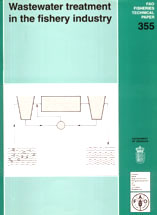

FAO FISHERIES TECHNICAL PAPER - 355
FOOD AND AGRICULTURE ORGANIZATION OF THE UNITED NATIONS
J.F. González
Department of Chemical Engineering
College of Engineering
National University of Mar del Plata
Mar del Plata, Agentina
FOOD AND AGRICULTURE ORGANIZATION OF THE UNITED NATIONS
Rome, 1996
| The designations employed and the presentation of material in this publication do not imply the expression of any opinion whatsoever on the part of the Food and Agriculture Organization of the United Nations concerning the legal status of any country territory city or area or of its authorities or concerning the delimitation of its frontiers or boundaries. |
M-09
ISBN 92-5-103788-4
All rights reserved. No part of this publication may be reproduced, stored in a retrieval system, or transmitted in any form or by any means, electronic, mechanical, photocopying or otherwise, without the prior permission of the copyright owner. Applications for such permission with a statement of the purpose and extent of the reproduction, should be addressed to the Director, Publications Division. Food and Agriculture Organization of the United Nations. Via delle Terme di Caracalla, 00100 Rome, Italy.
© FAO 1996
This electronic document has been scanned using optical character recognition (OCR) software and careful manual recorrection. Even if the quality of digitalisation is high, the FAO declines all responsibility for any discrepancies that may exist between the present document and its original printed version.
2. WASTEWATER CHARACTERIZATION
2.2.1 Biochemical oxygen demand
2.2.2 Chemical oxygen demand
2.2.3 Other methods for estimation of organic content
2.2.4 Relationships between estimates of the organic content
2.2.5 Oil and grease
2.3 Nitrogen and Phosphorous
2.4 Characteristics of Fish Processing Wastewaters
2.5 Sampling
2.6 Discharge Limits
3.1 Screening
3.2 Sedimentation
3.3 Separation of Oil and Grease
3.4 Flotation
4.1.1 Activated Sludge Systems
4.1.2 Aerated lagoons
4.1.3 Aeration
4.1.4 Trickling filters
4.1.5 Rotating biological contractors
4.1.6 Selection of aerobic treatments
5. PHYSICO-CHEMICAL TREATMENTS
6. SLUDGE TREATMENT AND DISPOSAL
6.1 Sludge Transportation to Treatment Facilities
6.2 Sludge Digestion
6.3 Land Disposal of Sludges
6.4 Sludge Disinfection
7.1 Cost of Unitary Processes
7.2 Cost of Operation and Maintenance
7.3 Capital Costs
7.4 Estimation of Total Costs